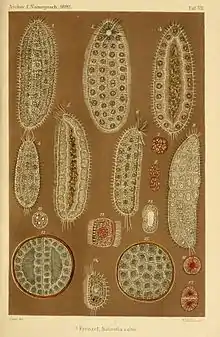Salinella
Salinella salve is a dubious species of a very simple animal that may not exist, but which some have named as the sole member of the phylum Monoblastozoa. It was discovered in 1892 by Johannes Frenzel in the salt pans of Argentina and cultivated in a laboratory by him. This animal has not been found since and its real existence is considered as doubtful.[1][2] Michael Schrödl from the Zoological State Collection in Munich is involved in a project to search for Salinella in Argentina.[3][4]
| Salinella | |
|---|---|
 | |
| Johannes Frenzel's illustrations, 1892 | |
| Scientific classification | |
| Domain: | Eukaryota |
| Kingdom: | Animalia |
| Phylum: | Monoblastozoa R. Blackwelder, 1963 |
| Family: | Salinellidae |
| Genus: | Salinella J. Frenzel, 1892 |
| Species: | S. salve |
| Binomial name | |
| Salinella salve J. Frenzel, 1892 nomen inquirendum | |
Monoblastozoa was granted the title of phylum after the recognition that Mesozoa was too diverse to be a phylum into itself.
Description
According to Frenzel's description, S. salve is more organized than Protozoa, but still very primitive for a multicellular organism. They are characterised by their distinct anterior/posterior parts and being densely ciliated, especially around the "mouth" and "anus". They have only one layer of cells, and reproduce asexually by transverse fission of their bodies. Although sexual reproduction was suspected, Frenzel did not observe it.[5]
See also
- Mesotardigrada – another high rank taxon whose sole member has not been independently verified to exist
References
- Brusca, R. C.; Brusca, G. J. (2005). Invertebrados (2nd ed.). Madrid: McGraw-Hill-Interamericana. ISBN 978-0-87893-097-5.
- Taylor, Christopher (June 27, 2007). "Salinella - what the crap was it?". Catalogue of Organisms.
- Dunning, Hayley (October 1, 2012). "Gone Missing, circa 1892". The Scientist.
- Viering, Kerstin (November 23, 2012). "Jäger der verborgenen Art". Spektrum.
- Frenzel, Johannes (1892). "Untersuchungen über die mikroskopische Fauna Argentiniens". Archiv für Naturgeschichte (in German). 58: 66–96, Plate VII.
External links
 Media related to Salinella salve at Wikimedia Commons
Media related to Salinella salve at Wikimedia Commons Data related to Salinella salve at Wikispecies
Data related to Salinella salve at Wikispecies